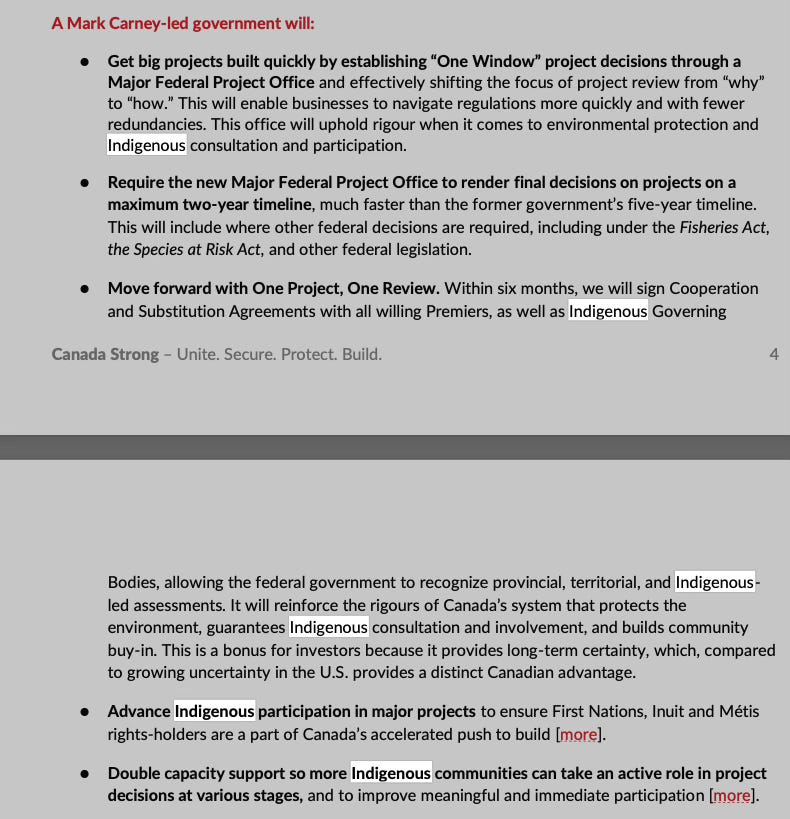Carney's Indigenous platform
A solid C+
The Liberal Platform is out, it has 73 mentions of Indigenous peoples. Mostly it’s used as the small-L liberal version of (PBUH). However there are a few bits with substance in the platform, and they paint a picture of a boffin’s approach to winning over First Nations support for rapid industrial development.
Carney seems to understand that First Nations will be a spoiler for any development work if we are not involved early and intensely. He promises to create what he calls a “One Window” Project office to get projects approved.
But he must know that if a single First Nation in the project area opposes it, the courts will call the One Window approach insufficient.
To address that he needs to do two things:
Expand First Nations capacity to handle all these development inquiries
Provide an incentive for First Nations not to oppose development
First Nations are already far beyond capacity to handle the 500,000 or so consolation requests they see each year. Most of those are for minor projects that don’t matter much and are often ignored — but major projects require a response, communities demand it.
My First Nation’s territory covers both sides of the Fraser River — more than $300 billion dollars of Canadian trade crosses our territory. Our referrals and consultations office may have 2 people in it. There are 40 First Nations in the same position, along this one key route to the Pacific, and to Asian markets.
We do not presently have the ability to facilitate a rapid, “One Window” approach. We don't have the staff to gather community feedback, conduct research, or write reports — to do all that and respond stretches our internal resources to a breaking point. And the sad fact is that, it’s just easier to sue and oppose things.
First Nations are democracies, and populist ones at that. Fighting big government is as popular here as it is in Alberta. And what’s worse — fighting doesn’t require staff time or political capital. All it takes is an outside lawyer.
Carney seems to recognize this and has promised to double capacity funding.
That may not be enough. In some nations, it might need to go up 5-fold to get consultations through in a timely manner. That deals with the ‘how’, but it doesn’t deal with the ‘why’, as in: ‘why would a First Nation work to approve a development on their territory?’
Poilievre’s Conservatives have an answer for ‘why’. Theirs is creating tax space for First Nations that approve developments — allowing them to directly tax projects they’ve approved. Unfortunately that also comes with a poison pill, in the form of a demand that this money be spent on basic services like clean drinking water. Those services are currently a federal responsibility, so the demand that Nations use this new tax revenue to cover drinking water implies cuts to Federal funding for First Nations. It’s a stick that’s been painted orange to look like a carrot.
So what’s Carney’s version of the ‘why’? I think it’s this — a promise to increase land added to reserves.
I can’t tell if he intends this to be his ‘why’. The Liberals have been working on policy around Additions to Reserve (ATRs) for a while. Is this more of the same, or is this an expansion?
As someone who works in retail politics on reserve, I can tell you this: I have no reason to risk my own political capital to get a development project approved. I may have the resources for it with Carney’s promise of capacity funding, but why would I deploy those resources to help some extractive industry dig up our land, pollute our river, and give us nothing?
However if each development project ended with a promise, for example, to cede the land the ‘man camps’ were built on to us when the project was finished… that I can sell, that becomes a priority for me.
I want to hear more from Carney on this promise, and what it means, and how it’s connected to development.
As for everything else in his Indigenous policy, it seems to be staying the course with the last term. I would have liked to have seen a promise to criminalize residential school denialism, and to stick to the 5% Indigenous procurement commitment. The latter is going to be a challenge as military procurement forms a larger and larger portion of the federal budget. Military contracts are big, and beyond the capacity of many First Nations businesses. Those businesses will need federal support or a mechanism to move that 5% further downstream or make it up with even higher rates of procurement spending in other departments.
I’m looking forward to seeing the Conservative platform to compare. But this is so far, a sufficient start, a solid C+. It’s too vague to call it ‘good’ — surprising, from a man known for speaking in paragraphs.





I suspect the procurement quota is likely gone, particularly given the prominent pretendian stories we saw. It's a solvable challenge but one that takes political courage that seems to be in short supply.